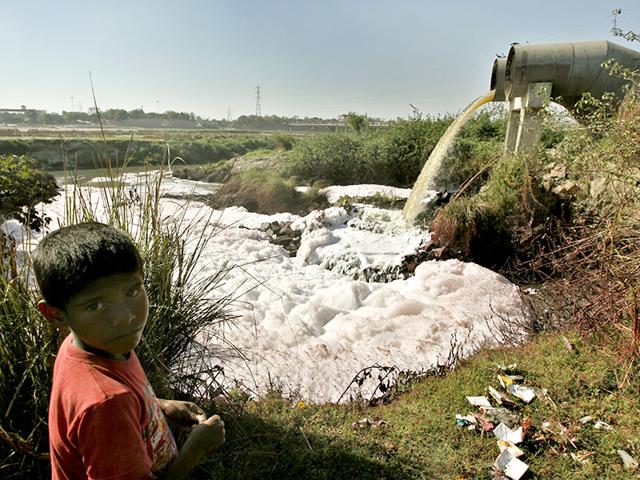Delhi can either go the industrial way or become a green city
With its patterns of over-expansion, Delhi can either go the industrial way or set an example by becoming a green city writes Gautam Bhatia
A significant revelation from a recent conference on cities was that most Indian towns do not follow projected patterns of growth.

Historically, Jaipur was a city of artisans and tourists, Shimla, a summer capital, Jamshedpur and Ludhiana, manufacturing hubs, Chandigarh and Bhubaneshwar, administrative centres, among others. But the current evaluation of these cities points to a completely different direction.
Factors like population, migration, employment, culture, education, health and lifestyle determine their current and future status.
While Mumbai and Bengaluru stood firm as business centres, Kolkata’s status was undermined by its low commercial output; Shimla’s status was reduced to that of a slum due to its poor tourism infrastructure and overbuilding; Kochi’s maritime status has been enhanced with art to a cultural destination. Demographic changes over the last half-century are a major reason for these alterations.
The most serious deviation occurred in the Capital —designated as a seat of government with low-lying green space, which is now overshadowed by ill-health, pollution, migration, lawlessness and the rise of illegal industries.
Delhi’s unmanaged ad-hoc growth has effectively obliterated all notions of space and planning.
At one time the heart of the city was Connaught Place; a few decades later, the spread of district centres started to attract the population.
Industries were then shifted to the outskirts. A few decades on, residential areas engulfed the same factory and industrial spaces which they were trying to escape. This uncontrolled expansion defeated a planned separation.
Today, facilities like power plants, airports, army cantonments and highways, which were intended for the outskirts, have been absorbed into the sprawling expanse.
In fact the rationale for civic conditions is thwarted daily. People commute incessantly as their place for work and recreation are entirely unlinked to their homes. Meanwhile, a cancerous river snakes its way through the centre of the town as much of the city’s unmanaged waste is lying out in the streets or is choking its drains.
In the UN’s livability list of 150 world cities, Delhi stands at a dismissal 132 (13 of the world’s 20 ‘worst places to live’ are in India). Some West African towns scored higher on living conditions like health, education, medical facilities and infrastructure, but were ranked lower than Delhi because of higher crime rates.
With levels of particulate matter in the air several times higher than acceptable WHO norms, the Capital also topped the list of the world’s most polluted cities.
Many factors like coal burning, industrial effluents, illegal fires, and vehicular exhaust contribute to it, but the increasing pollution is also the result of rising population densities, the proliferation of small-scale polluting factories within the city limits, and others that run illegally at night.
Yet, many of these illegal operations keep almost 40% of the city’s migrant labour employed.
Despite its density and zoning regulations, Delhi’s sanitation and public health standards are abysmal, similar to its manufacturing and industrial township neighbours like Ghaziabad, Kanpur, and Moradabad. Keeping a check on the population, ill-health, diseases and declining life spans cannot be serious considerations when the city’s primary thrust is on creating jobs, accommodating its increasingly affluent people and cars.
Cities, like people, keep changing their functions and residence. Delhi’s hundred-year-old history of being the Imperial capital has reached a dead-end.
Moreover, its importance has often been overstated, by its old residents. The city’s mega size now dwarfs its image of being a pseudo Colonial-Mughal paradise.
The city’s degrading environmental status, increasing shortages of utilities and basic services, and indifferent state of governance, suggests an altogether different future for Delhi.
What then does the Delhi experience suggest for future cities of the country? Will they too witness a polluted, industrialised, smoke-filled, monoxide-contaminated nightmare?
The real test of the government’s approach to city planning will require a vast change in attitudes and a questioning of current approaches.
Should people be fined for commuting long distances in the city and adding to the pollution levels? Should municipalities collect health tax from contaminating actors?
Should residents, who do not own vehicles avail public transport for free?
The answers may generate a different sort of urban growth, one that is not measured by GDP, but levels of wellness. A society that sees wealth in clean air, shared water and civic resources will generate an altogether different architecture for its cities.
At this late stage in the game, Delhi has two choices: It can shift the central government to a smaller town which would allow the city to cater — without guilt — to the industrial townships. The changed status would not just be an official recognition of its current thoughtless patterns of growth, but will encourage more industry, migration and traditional mohalla housing in keeping with its image as a factory town.
Or, it can choose the path to ecology — healing itself, reducing emissions, cleaning its river, limiting private transport, curbing industrial pollution, setting the first-of-its-kind example of being urban India’s first green city. It is a decision that the government can no longer ignore.
Gautam Bhatia is a Delhi-based architect
The views expressed are personal





